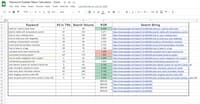If you want to quickly establish credibility and authority for a new website, one proven option is building it on an “aged” domain name.
But how exactly do aged domains work? How do you find a good one? And are they worth the investment?
To dig into these questions, I connected with Alex Drew, founder and CEO of Odys Global – a leading marketplace for premium aged domains.
With over 15 years experience in internet marketing and aged domains, Alex offered invaluable technical and strategic insights on leveraging aged domains in the podcast interview.
Let’s unpack the key highlights.
Want another format?
🎥 Interview on YouTube (1-hour)
🎧 Podcast, 1-hour interview (or on your podcast player)
What Are Aged Domains?
First, what qualifies a domain as “aged”? As Alex explained:
“An aged domain is a domain name that has been registered for a long time and has built up search engine authority and intrinsic value over the years.”
The critical defining aspect is the domain has substantial history behind it. While definitions vary slightly, most aged domain experts consider 5-10 years or older to meet the criteria.
Over many years, these aged domains accumulate valuable assets:
- Backlinks – from other sites linking to content hosted on the domain.
- Referring domains – the number of unique external sites linking to the domain.
- Traffic – visitors who land on the domain, often seeking its established brand.
- Branding – recognizability and trust around the domain name itself.
This provides a solid intrinsic foundation of SEO authority and credibility.
Aged domains differ from expired domains – those allowed to lapse in their registration period before being re-acquired. As Alex noted, the terminology has blended over recent years:
“As a matter of fact, lots of our inventories around 15 to 20% right now, is sites that make good aged domains.”
Now “aged domain” refers more broadly to any domain name with a substantive history and accumulated intrinsic value.
Why Aged Domains Matter
What unique benefits can aged domains provide compared to simply registering a brand new domain?
Alex emphasized that their strategic value stretches far beyond just an initial rankings boost for a new site.
“I always recommend to view aged domains beyond, you know, the SEO, the basic SEO approach.”
Specifically, it is the assets the domain has accrued over its lifetime that make it strategically useful:
“Their backlinks, history, and branding can help provide authority and trust for a new site.”
When you build a website on a properly vetted aged domain, it’s like assuming the legacy and equity of an existing business.
You effectively inherit the domain’s pre-existing backlink profile, brand recognition, and community. This lends your new website significantly more credibility than starting completely from scratch with a new domain registration.
It offers an enormous head start in building authority and trust.
Business Example
Think of it this way…
Imagine you launch a new financial advice website. You require time to build credibility, traffic, and community trust as an expert resource.
Now imagine you purchased and rebranded the domain name of a longstanding, now-defunct financial advice platform.
That aged domain likely has:
- Hundreds of high-quality backlinks
- Strong branding signals
- Referral traffic from old links
- Existing community recognition
By acquiring this domain, you inherit much of the hard-earned authority and trust it holds.
Your new site essentially builds upon the domain’s established foundation – rather than starting from zero.
This demonstrates the immense strategic advantage aged domains can provide. But finding the right domain takes some work…
Assessing Aged Domain Quality
Not all aged domains are made equal. You want to thoroughly assess prospective domains across a few key factors:
Backlink Profile & Relevance
Domain authority metrics like DA and DR provide a helpful baseline for gauging authority. However, as Alex strongly advised:
“Forget about metrics. The first thing that you should do, check the backlinks profile and see if there is any value in that.”
Specifically, you want to inspect:
- The quality of the linking root domains – are they authoritative in your niche?
- The relevancy of the anchor text links – are they contextual or artificial?
- Any suspicious link patterns – unnatural anchor text mixes or placements
A profile with highly relevant links from niche authority sites demonstrates strong potential value.
History of Spam/Abuse
Any past involvement in shady linking schemes, over-optimization tactics, paid links, or spam could make a domain too risky to build upon.
Thoroughly research the brand name online and use archive tools like Wayback Machine to inspect the domain’s historical content and linking patterns.
Still Ranking for its Brand?
Legitimate aged domains with strong backlink histories tend to retain at least some search visibility – even when neglected temporarily.
Check if the domain still ranks well for searches specifically on its core brand name terms. No rankings could signal problems.
Trademark Concerns
An aged domain could potentially have trademark issues if the name is registered to another established company.
You may be able to legally buy the domain itself, but not use it commercially for a website in certain niches. Definitely confirm trademark validity.
Finding & Acquiring Quality Aged Domains
Now you know how to spot a promising aged domain – but where do you find them? Alex suggested two primary options:
Domain Auction Platforms
Dropped domain auction sites like GoDaddy Auctions, NameJet, etc provide massive inventories of expired domains up for sale.
However, you bear the burden of deeply vetting each prospective domain on your own. As Alex cautioned:
“There are lots of hidden risks, and that’s where marketplaces like ours come into place.”
Domain auctions can also see prices inflated by hype bidding wars.
Aged Domain Marketplaces
Specialized aged domain marketplaces like Odys curate available domains that pass extensive evaluations. As Alex explained:
“Saving you so much valuable time. Then we have other marketplaces like Collins SEO domains.”
These marketplaces research and handle vetting aged domain inventories, at an increased price point. But this saves you ample time and reduces acquisition risks.
To reliably source “diamonds in the rough” yourself on auction platforms requires dedicating considerable expertise and resources towards manual verification processes and API tools.
Either route you take, Alex emphasized thoroughly vetting domains:
“The way I see it, like ODS Global as a domain has around dozen redirects in right now.”
Conducting detailed due diligence is critical, but marketplaces can help streamline the process substantially.
The Future Outlook for Aged Domains
Given the rise of artificial intelligence, could aged domains lose relevance in the coming years?
Alex believes their strategic value will only continue increasing:
“I still believe brands will strongly impact how people trust information online or the way they actually interact with information or follow someone’s advice.”
In his viewpoint, the future focus will be on premium aged domains – those combining inherently strong brand names with accumulated SEO authority.
It’s not a sponsored post, but I’m an affiliate for Odys. Please check out the marketplace if you’re interested.
Get $100 in your new Odys account if you sign up with my affiliate link.
Key Takeaways
- Aged domains provide SEO and credibility advantages thanks to their backlink and brand history.
- Thoroughly vet all prospective domains to avoid past abuse/penalty risks.
- Domain authority metrics are useful – but evaluate contextual links more closely.
- Finding genuinely premium aged domains requires expertise and diligent analysis.
- Marketplaces offer curated inventory but at increased prices.
- Branded domain names will likely gain further importance amidst AI.
While the aged domain ecosystem keeps evolving, their strategic potential endures. With the proper aged domain asset, you can establish a strong authoritative foundation for a new website to flourish upon.
Hopefully this provides greater clarity on effectively navigating the intricate but promising world of aged domains.



